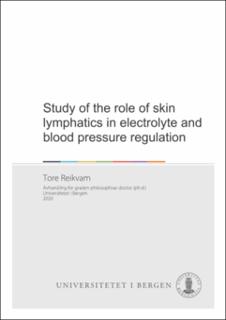Study of the role of skin lymphatics in electrolyte and blood pressure regulation
Doctoral thesis
Permanent lenke
https://hdl.handle.net/1956/21467Utgivelsesdato
2020-02-21Metadata
Vis full innførselSamlinger
Sammendrag
Cardiovascular diseases are the major cause of death worldwide and represent a dramatic socio-economic challenge. Hypertension accounts for 18% of cardiovascular disease deaths in the Western countries, and is a major risk factor for stroke, coronary heart disease and heart failure. Excessive dietary salt intake is known to be a risk factor for developing hypertension, but the pathophysiology of salt sensitive hypertension is poorly understood. The kidneys are the main regulators of Na+ and water in the body. Salt sensitive hypertension has traditionally been explained by an impaired capacity of the kidneys to excrete Na+, resulting in water retention and thereby a progressive alteration in the filling of the vasculature, resulting in increased blood pressure. Recent studies have suggested that Na+ can be retained or removed from the body without commensurate water, and that the skin may function as sodium reservoir. It has been shown that the Na+ accumulation is controlled by immune cells and involves modification of the extracellular matrix and lymphangiogenesis in the skin. In this thesis we therefore addressed three major questions to clarify aspects of the new hypothesis proposing the skin as a contributor to Na+ and blood pressure homeostasis; 1) What are the microcirculatory effects of increased lymphatic vasculature in the skin, 2) are new lymph vessels induced by Na+ retention functional, and 3) does lymphatic vasculature in the skin affect Na+ accumulation and blood pressure homeostasis. To study the microcirculatory effects of a chronically expanded lymphatic vasculature in the skin we used K14-VEGF-C mice overexpressing vascular endothelial growth factor-C (VEGF-C), resulting in an expanded lymphatic network in skin. Acute and chronic inflammation resulted in increased interstitial fluid pressure and reduced lymph flow, but to the same extent in transgenic mice and WT controls. However, after local overhydration in the skin we observed increased lymph flow and fluid transport in the transgenic mice. Despite increased production of the immune cell chemoattractant CCL21 in K14-VEGF-C mice, local inflammation did not result in an increased number of migrating immune cells from the skin to the draining lymph node. We concluded that lymphangiogenesis might enhance clearance of fluid in situations with increased fluid filtration. Sodium accumulation in the skin is suggested to be regulated by macrophages that secrete VEGF-C in response to a hyperosmotic microenvironment thereby stimulating lymphangiogenesis. An important question is whether these newly formed vessels are functional. After salt loading in rats we measured lymph flow in skin and muscle with optical imaging and a newly developed PET-CT method. Increased lymph flow was observed in skin as well as muscle. A reduction of lymph flow was observed after macrophage depletion in the skin. Our findings suggest that newly formed lymphatic vessels are functional, and that macrophages may be involved in the regulation of lymph flow and thereby clearance of Na+ from tissues. Previous studies have shown that mice lacking lymphatics in the skin develop higher blood pressure after salt loading. To address the question whether lymphatic vasculature in skin is important for Na+ accumulation and blood pressure homeostasis, we used genetically engineered mice with either increased or reduced lymphatic vasculature in the skin. Blood pressure was measured with telemetric recording before salt loading and at the termination of the experiment. Tissue samples from skin and muscle were harvested for analysis of Na+ and K+ concentration. We found no differences in Na+ accumulation or blood pressure response between genetically engineered mice and normal controls. Our results suggest that lymphatic vasculature in skin does not have an important role in electrolyte and blood pressure homeostasis in mice.
Består av
Paper I: Karlsen TV, Reikvam T, Tofteberg A, Nikpey E, Skogstrand T, Wagner M, Tenstad O, Wiig H (2017) Lymphangiogenesis Facilitates Initial Lymph Formation and Enhances the Dendritic Cell Mobilizing Chemokine CCL21 Without Affecting Migration. Arterioscler Thromb Vasc Biol. 2017 Nov;37(11):2128-2135. The accepted version is available in the main thesis. The published version is available at: https://doi.org/10.1161/ATVBAHA.117.309883Paper II: Karlsen TV, Nikpey E, Han J, Reikvam T, Rakova N, CastorenaGonzalez JA, Davis MJ, Titze JM, Tenstad O, Wiig H (2018) High-Salt Diet Causes Expansion of the Lymphatic Network and Increased Lymph Flow in Skin and Muscle of Rats. Arterioscler Thromb Vasc Biol. 2018 Sep;38(9):2054-2064. The accepted version is available in the main thesis. The published version is available at: https://doi.org/10.1161/atvbaha.118.311149
Paper III: Reikvam T, Karlsen TV, Thowsen IM, Skogstrand T, Samuelsson AM, Tenstad O, Wiig H No evidence for a role of lymphatics in skin in electrolyte and blood pressure homeostasis in mice. Manuscript. The article is not available in BORA.
